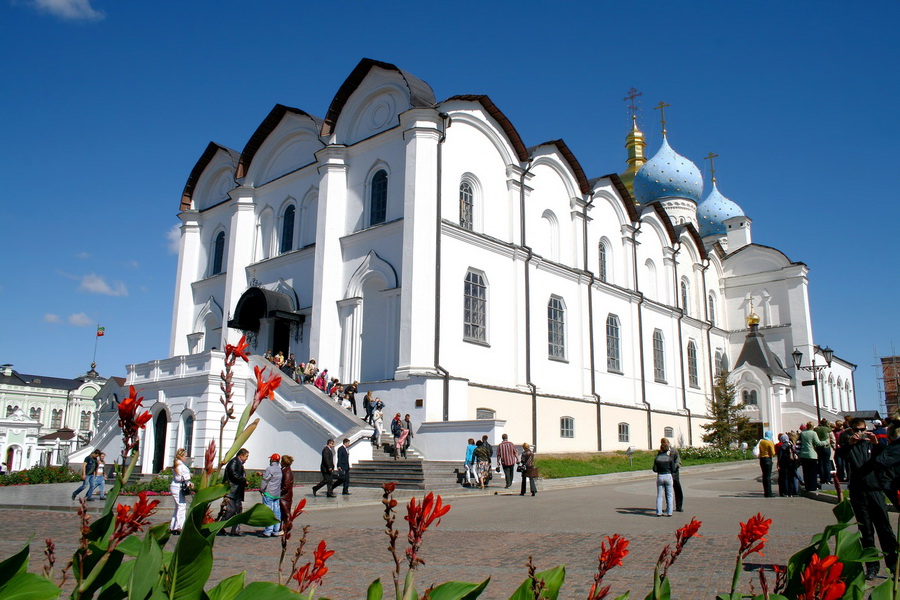
Annunciation Cathedral in the Kazan Kremlin is the oldest surviving building in Kazan, capital of Russia’s Tatarstan Republic. This unique example of Pskov architecture defines the massive fortress with its delightful blue domes and air of royalty.
The construction of a wooden church on the site of Annunciation Cathedral is associated with the capture of Kazan on the Volga River by Ivan IV, otherwise known as Ivan the Terrible. The wooden chapel was hastily built in 3 days and consecrated in the presence of the Tsar in 1552.
Construction of a stone church began immediately after the completion of its wooden predecessor. Built by the architects of St. Basil’s Cathedral, it was modeled after Moscow Assumption Cathedral and took seven years to build. The original church had five domes and two side chapels, and its beautiful white sandstone exterior set the standard for subsequent white Kremlin buildings Over the next three centuries, it was rebuilt several times.
In the 17th century, a bell tower was added to the church, and Annunciation Cathedral soon displayed the largest bell in the city, which weighed two tons. In the 18th century, the central aisle was rebuilt to reflect the Baroque style fashionable at the time, and in the 19th century a refectory was added and heating installed. At the end of the 19th century, an underground church was consecrated beneath the altar which would later serve as a tomb for high-ranking church officials.
Numerous renovations on Annunciation Cathedral gradually erased its likeness to Moscow Cathedral. Until 1918, it maintained its status as the central church of the Diocese of Kazan. It housed the Bishop's chair, ordained priests and, from the end of the 19thcentury, consecrated bishops to the episcopate.
The modern decor of Annunciation Cathedral is a restoration based on old manuscripts and photographs of its original appearance. Initially, the cathedral was decorated with frescoes, and one which depicts the Trinity can still be seen near the chandelier. The church also has a 19th-century oil painting created by a famous regional iconographer. Although the iconostasis is new, it was recreated to reflect the styles of the 16th-17th centuries. Its most revered icons are the relics of Guria, the first archbishop of Kazan.
Annunciation Cathedral has long had a reputation of sanctity which has attracted many notable visitors. Throughout history, writers including Pushkin and Korolenko, the composer Rachmaninoff and Peter I, Catherine the Great and Nicholas I have all visited the church.
In 1919, a secret room containing a large collection of ancient church utensils was discovered in Annunciation Cathedral and the relics transferred to Annunciation Cathedral Museum. In 1925, the church itself was placed under the administration of the museum, which allowed its frescoes and floor mosaics to be preserved during the reign of Stalin. Unfortunately, it was impossible to fully protect the church property; the underground rooms were used as storage for produce and the bell tower completely demolished.
Restoration of the church began in 1985. After its completion in 2005, in conjunction with the new Kul Sharif Kremlin Mosque nearby, its doors were again opened for visitors and parishioners. Today, Annunciation Cathedral is not only a place of worship but also a museum, with ancient icons and clerical books on display. The pride of this collection is the original staff of Archbishop Guria.
Annunciation Cathedral in the Kazan Kremlin is open daily from 9am to 7pm. Entrance is free, and services are held on weekends and holidays. Annunciation Cathedral Museum is open daily from 10am to 6pm, although the ticket office closes half an hour before the museum. Visitors can tour the cathedral in conjunction with other buildings in the complex, including the Kremlin Palace.

